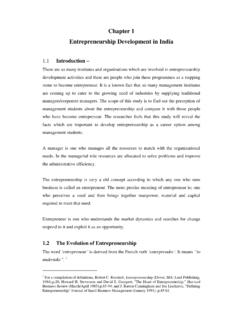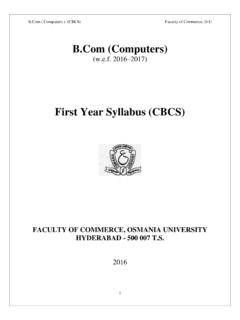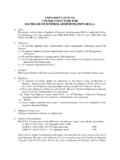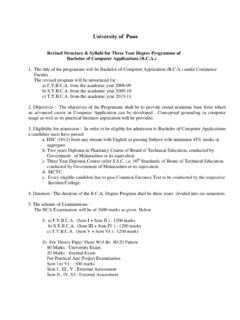Transcription of Impacts of Information Technology on Society in …
1 Konsbruck Robert LeeRoute de Chavannes, 27 CCH-1007 Lausanne-VidySwitzerlandImpacts of Information Technologyon Society in the new Century1 IntroductionIn the past few decades there has been a revolution in computing and communications, andall indications are that technological progress and use of Information Technology will continueat a rapid pace. Accompanying and supporting the dramatic increases in the power and useof new Information technologies has been the declining cost of communications as a result ofboth technological improvements and increased competition. According to Moore s law theprocessing power of microchips is doubling every 18 months.
2 These advances present manysignificant opportunities but also pose major challenges. Today, innovations in informationtechnology are having wide-ranging effects across numerous domains of Society , and policymakers are acting on issues involving economic productivity, intellectual property rights, privacyprotection, and affordability of and access to Information . Choices made now will have long-lasting consequences, and attention must be paid to their social and economic of the most significant outcomes of the progress of Information Technology is probablyelectronic commerce over the Internet, a new way of conducting business.
3 Though only a fewyears old, it may radically alter economic activities and the social environment. Already, itaffects such large sectors as communications, finance and retail trade and might expand toareas such as education and health services. It implies the seamless application of informationand communication Technology along the entire value chain of a business that is following sections will focus on the Impacts of Information Technology and electroniccommerce on business models, commerce, market structure, workplace, labour market, educa-tion, private life and Society as a Business Models, Commerce and Market StructureOne important way in which Information Technology is affecting work is by reducing the im-portance of distance.
4 In many industries, the geographic distribution of work is changingsignificantly. For instance, some software firms have found that they can overcome the tight lo-cal market for software engineers by sending projects to India or other nations where the wagesare much lower. Furthermore, such arrangements can take advantage of the time differencesso that critical projects can be worked on nearly around the clock. Firms can outsource theirmanufacturing to other nations and rely on telecommunications to keep marketing, R&D, anddistribution teams in close contact with the manufacturing groups. Thus the Technology canenable a finer division of labour among countries, which in turn affects the relative demand forvarious skills in each nation.
5 The Technology enables various types of work and employmentto be decoupled from one another. Firms have greater freedom to locate their economic activ-ities, creating greater competition among regions in infrastructure, labour, capital, and other1resource markets. It also opens the door for regulatory arbitrage : firms can increasingly choosewhich tax authority and other regulations and communication technologies also promote more market-like forms of produc-tion and distribution. An infrastructure of computing and communication Technology , providing24-hour access at low cost to almost any kind of price and product Information desired by buy-ers, will reduce the informational barriers to efficient market operation.
6 This infrastructuremight also provide the means for effecting real-time transactions and make intermediaries suchas sales clerks, stock brokers and travel agents, whose function is to provide an essential infor-mation link between buyers and sellers, redundant. Removal of intermediaries would reducethe costs in the production and distribution value chain. The Information technologies havefacilitated the evolution of enhanced mail order retailing, in which goods can be ordered quicklyby using telephones or computer networks and then dispatched by suppliers through integratedtransport companies that rely extensively on computers and communication technologies tocontrol their operations.
7 Nonphysical goods, such as software, can be shipped electronically,eliminating the entire transport channel. Payments can be done in new ways. The result is dis-intermediation throughout the distribution channel, with cost reduction, lower end-consumerprices, and higher profit impact of Information Technology on the firms cost structure can be best illustratedon the electronic commerce example. The key areas of cost reduction when carrying out a salevia electronic commerce rather than in a traditional store involve physical establishment, orderplacement and execution, customer support, staffing, inventory carrying, and distribution.
8 Al-though setting up and maintaining an e-commerce web site might be expensive, it is certainlyless expensive to maintain such a storefront than a physical one because it is always open, canbe accessed by millions around the globe, and has few variable costs, so that it can scale up tomeet the demand. By maintaining one store instead of several, duplicate inventory costs areeliminated. In addition, e-commerce is very effective at reducing the costs of attracting newcustomers, because advertising is typically cheaper than for other media and more , the electronic interface allows e-commerce merchants to check that an order is inter-nally consistent and that the order, receipt, and invoice match.
9 Through e-commerce, firms areable to move much of their customer support on line so that customers can access databases ormanuals directly. This significantly cuts costs while generally improving the quality of shops require far fewer, but high-skilled, employees. E-commerce also permitssavings in inventory carrying costs. The faster the input can be ordered and delivered, theless the need for a large inventory. The impact on costs associated with decreased inventoriesis most pronounced in industries where the product has a limited shelf life ( bananas), issubject to fast technological obsolescence or price declines ( computers), or where there isa rapid flow of new products ( books, music).
10 Although shipping costs can increase thecost of many products purchased via electronic commerce and add substantially to the finalprice, distribution costs are significantly reduced for digital products such as financial services,software, and travel, which are important e-commerce electronic commerce causes the disintermediation of some intermediaries, it createsgreater dependency on others and also some entirely new intermediary functions. Among theintermediary services that could add costs to e-commerce transactions are advertising, secureonline payment, and delivery. The relative ease of becoming an e-commerce merchant andsetting up stores results in such a huge number of offerings that consumers can easily beoverwhelmed.








